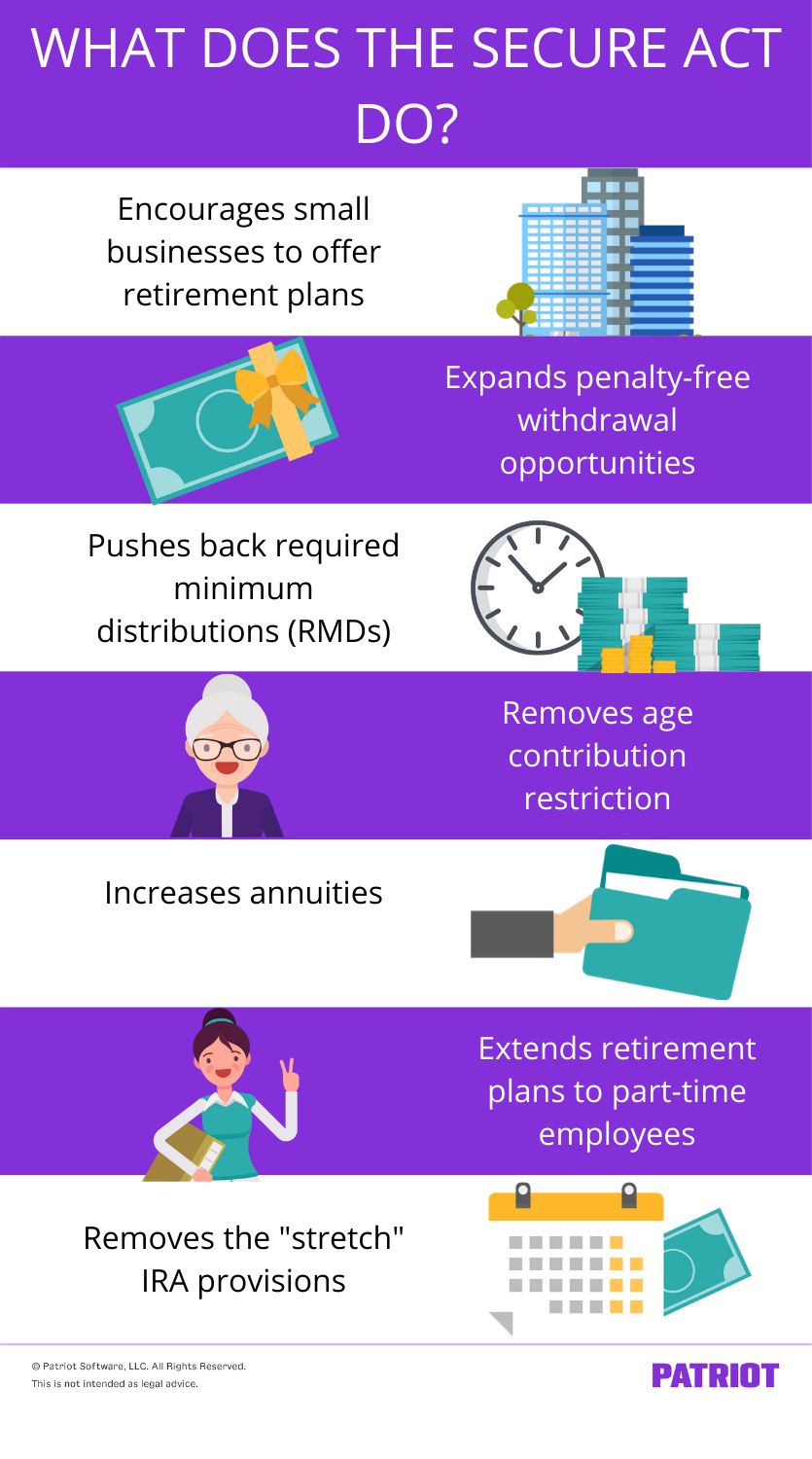In 2022, a new retirement savings bill was signed into law, further expanding retirement savings. Learn more about the SECURE Act 2.0 for more information on the latest law!
Small business retirement plans are great benefits that encourage employees to start saving for life after the workforce. Do you offer your employees retirement plan options? If you do, you may be impacted by the SECURE Act of 2019. So, what is the SECURE Act?
What is the SECURE Act?
The SECURE Act stands for Setting Every Community Up for Retirement Enhancement Act. It became law in December 2019, with changes taking place January 2020. The SECURE Act of 2019 encourages small employers to offer employees retirement plan options and expands employees’ benefits and contribution opportunities.
This law applies to both 401(k) and IRA plans. Whether you offer employee retirement plans or not, you should understand the implications the SECURE retirement Act has.
As a brief recap, IRA and 401(k) plans are retirement options that come with a slew of rules, such as contribution eligibility and limits, withdrawal requirements, and early-withdrawal penalties.
And now, under the SECURE Act, some of those rules have changed.
What does the SECURE Act of 2019 do?
Now that we’ve discussed what is the SECURE Act, you’re probably wondering what exactly it does. Take a look at what the SECURE Act does for both employers and workers.

1. Encourages small businesses to offer retirement plans
One reason for the SECURE Act’s arrival is to encourage small business owners to offer employees retirement plans. According to the Bureau of Labor Statistics, only 46% of employees in a business with fewer than 100 workers had access to defined contribution plans in 2018.
The SECURE Act aims to boost retirement plan offerings in small businesses. To do this, the act:
- Makes it easier for small business owners to offer employees retirement plans
- Increases the tax credit employers can receive for establishing a retirement plan
Two or more employers can come together to offer their employees retirement plan access through a multiple employer plan (MEP). Before the SECURE Act, each member of the MEP was responsible for having its own plan. But now, the SECURE Act will let all members of an open MEP work within one retirement plan. Keep in mind that this part of the SECURE Act won’t start until 2021.
If you implement a retirement plan, you can claim a business tax credit for 50% of its startup costs, up to $5,000 (up from $500). Here’s another piece of good news: you can claim an additional tax credit of $500 for three years if you include automatic enrollment in your plan.
2. Expands penalty-free withdrawal opportunities
Typically, retirement plan holders must pay a penalty of 10% (plus income tax) if they withdraw from their 401(k) or IRA accounts before they are 59.5 years old.
Before the SECURE Act of 2019, there were some exceptions to this rule. For example, account holders could make withdrawals without penalties to cover things like unreimbursed medical expenses or higher-education expenses.
But now, the SECURE Act lets account holders make penalty-free withdrawals if they have or adopt a child.
Account holders can withdraw up to $5,000 each following the birth or adoption of a child, without penalties. Account holders who repay the funds won’t owe income tax on the withdrawal.
3. Pushes back required minimum distributions (RMDs)
Prior to the SECURE Act, account holders were required to receive required minimum distributions from their accounts when they turned 70.5. These RMDs are the minimum amounts someone must withdraw from their account annually.
Under the SECURE Act, that RMD age has been pushed back to 72 years old. Now, account holders can wait until they turn 72 to begin withdrawing from their accounts.
So, what does this mean? This means that account holders can continue to grow their retirement fund amounts for another year and a half before withdrawing.
4. Removes age contribution restriction
The SECURE Act has also eliminated the age contribution restriction for IRA holders.
In the past, workers had to stop contributing to their IRAs when they turned 70.5. But now, under the SECURE Act, account holders can contribute to their IRAs as long as they are still working.
5. Increases annuities
Another change the SECURE Act brings is that it may increase annuities within 401(k) retirement accounts.
Annuities are insurance contracts that provide the account holder with steady cash flow from the insurer. Here’s how it works: you, the employer, deposit employee contributions with an insurer, who hangs onto the money and disburses them to the account holder at the appropriate time.
But, what happens if the insurer you choose doesn’t disburse the employee’s money down the line?
Before the SECURE Act, many employers set up 401(k)s without annuities to avoid potential lawsuits resulting from the insurer not disbursing the employee’s money.
However, the SECURE Act now provides a “safe harbor” for employers if they decide to set up annuities. Employers who meet certain requirements when selecting an insurer won’t be held liable if there are problems down the road.
6. Extends retirement plans to part-time employees
The SECURE Act also extends 401(k) eligibility to include more part-time employees. Prior to the SECURE Act, employees needed to work at least 1,000 hours during a 12-month period to contribute to a 401(k) plan.
Beginning in 2021, employees who work at least 500 hours in a 12-month period for three consecutive years can contribute to a 401(k) plan. These part-time employees must be 21 or older to contribute.
7. Removes the “stretch” IRA provisions
Here’s one provision of the SECURE Act that may throw some non-spouse IRA beneficiaries for a loop: the repeal of the stretch IRA.
In the past, beneficiaries who inherited a deceased account holder’s IRA could receive distributions indefinitely. These accounts could be passed from person to person without mandatory distributions.
Not anymore. Now, non-spouse beneficiaries must receive a full payout from their inherited IRA within 10 years of the original account holder’s death. This means that IRA funds cannot continue to grow indefinitely after an account holder has passed.
However, individuals who inherited an IRA before 2020 can continue stretching out the life of the account.
Ready to implement a retirement plan in your small business? Great! But, don’t forget to withhold employee contributions from their wages when running payroll. To make things easier on yourself, use Patriot’s payroll software to set and withhold contributions from employee wages. Get your free trial now!
This is not intended as legal advice; for more information, please click here.


